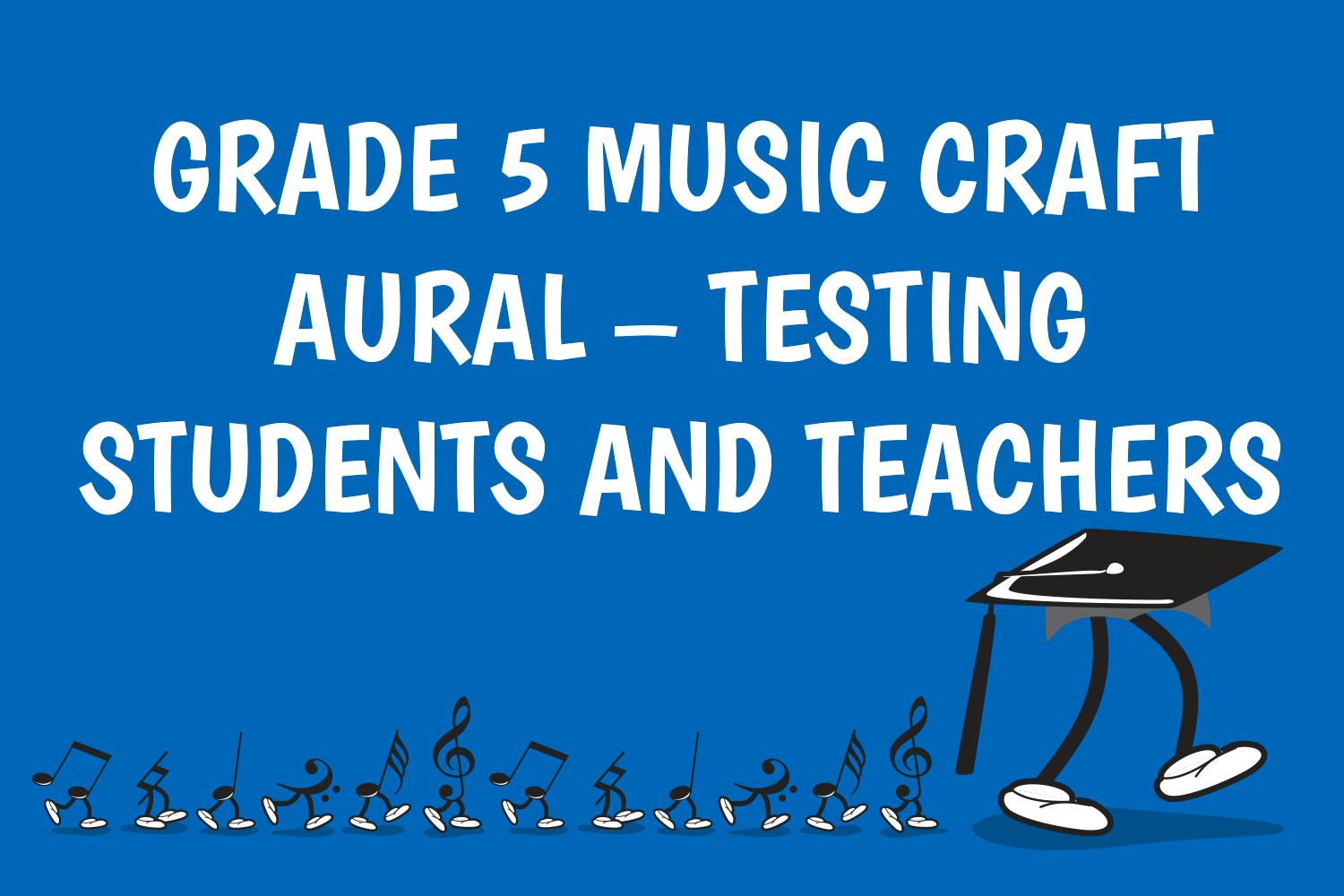Grade 5 Music Craft Aural – Testing Students AND Teachers

As most music teachers are aware, this year the AMEB released the next two instalments of the Music Craft series: Grades 5 and 6. In NSW these two levels were offered in the August series of exams.
Despite my best intentions, I unfortunately did not get around to studying for and sitting these exams. So instead I ordered the past papers and have finally gotten around to sitting down and doing them. This morning I decided to tackle the Grade 5 aural paper. It certainly was a most interesting experience!
Now before I describe the events of the last 40 minutes or so, I should say that I rate my aural skills as Very Good to Excellent. At the Con I took an exemption exam in first year and was told not to bother coming to aural classes for the rest of B.Mus. I was chuffed at the time, of course, but it has turned out to be rather a disadvantage when it comes to teaching, because in the end it would have been extremely useful to be in the room listening to aural being taught to people who struggled with it. My capabilities aurally do not help me understand what it’s like NOT to be able to hear a perfect fifth, for example. For those who have had to work really hard on their aural skills, they are able to pass on to their students all sorts of tricks of the trade in hearing things clearly. So the irony here is that the better one is naturally at aural, the harder it may be to teach it well.
I tend to use my own aural ability as a barometer for how my students will fare at certain activities. In the lower grades of Music Craft (Prelim to Grade 2) the answers are immediately obvious to pretty much all teachers, and most students! Grades 3 and 4 are more challenging, but even at this level I figure if I can’t get the answer in the first playing, it’s going to be very difficult for my students, and if it takes me any more than that, it will be quite impossible for them. (I should say at this point that these remarks apply to Music Craft only. The aural exams for Grades 4, 5 and 6 Musicianship are MUCH easier than even the Grade 3 Music Craft aural exam.)
So as I sat down to tackle Grade 5 I figured that I should still be at least 2-3 playings ahead of my students, also taking into account that they will have practised the skills in question, whereas I have not – I’m simply relying on my general aural ability.
The exam began with scale recognition. All three scales were played in crotchets, at about crotchet = 60, so there was plenty of time. It occurred to me that perhaps hearing them this slow might even be a disadvantage! After the first scale (Phrygian mode, on cello) was played 3 times, with huge pauses in between, I listened to the second scale (Major, on piano) and then quickly ducked into the kitchen to make myself a peppermint tea before coming back to name the third scale (harmonic minor on violin). I then chucked a few things in the dishwasher while waiting for question 1(b) to begin. All in all this section would have been absolutely fine for most students.
The next section was recognition of triads and this was much harder, because these were only played twice each. I used the second playing to check each one but could imagine most students really needing a third playing at least.
On to recognising chord sequences. I assumed the chord given was chord I6 in D major but it could have been chord iii6 in B minor as no key was stated. I got this progression in the first playing but felt that I was drawing on my years of experience and that it wasn’t really all that easy. Most students would need to practise this skill a great deal in order to achieve well in the exam.
Next: melodic dictation. It would have been very helpful to have been told how many bars long the melody would be, as well as the key (a B flat key sig was given, and a D to start, but I’ve fallen into that trap before in Grade 4. We are given the tonic chord, but without being told the key first, that adds another dimension to the test – hearing the tonality of the chord and having to decide in an instant whether the melody is in a major or minor key). The pulse was slow and I have to say I was surprised that the example was so long! There were a couple of tricky bits with accidentals too. So this took me all four playings to get, and I was glad of the last playing to check. According to my barometer, that makes it way too hard for my students, even if they’ve practised it all year.
Question 2 (all the previous being parts of Question 1) was a rhythm dictation in 9/8. No indication as to the number of bars, but a worrying 3 lines of manuscript to write on. I was glad I had already made my peppermint tea.
In the first playing I was thrown by the silence following the pulse, not quite being able to tell if there was an anacrusis, and the syncopation in the first bar. The fact that the whole thing was played on ONE NOTE on the violin did not help, as I couldn’t get a sense of any form or phrasing, and of course had no idea how many bars there were supposed to be anyway. In the second playing I was no better off, and started to giggle. In the third playing I was really chuckling but thought I might have worked out the final bar (but still didn’t know what number bar that would have been) and by the fourth playing I had tears streaming down my cheeks. At this point I called my friend and co-author Michelle Madder, whose aural ability surpasses mine by about a million light years, and played it to her over the phone. She was incredulous, to say the least, and hearing my squeaks in the background enquired as to whether it could perhaps be an elaborate joke. Suffice it to say the rhythm wasn’t immediately obvious to her either (and I can tell you this does not bode well for the rest of the population).
After I calmed down and my stomach muscles stopped hurting, I thought I had really better see if I could get this dictation. I think it took me about 7 playings. This is completely and totally off the scale, barometrically speaking.
Question 3 was on Form. I found this very confusing, as it was presented completely differently from the Grade 5 ‘Essential Exercises’ workbook (even the ‘Sample Aural Paper’ at the back of the book). I had to write ‘A’ for melodic repetition and ‘B’ for melodic contrast ‘as compared to the opening phrase’, but rather than simply write ABA etc. as I listened to the music, there were 8 lines on which to write answers for Phrase 1 through to Phrase 8. The score was not printed and it was impossible to know from listening whether the phrases were deemed to be 2 or 4 bars long (I happened to recognise the excerpt as being the Rondo from Beethoven’s piano sonata Op. 49 no. 1, but it didn’t help me!). No matter how I tried to interpret it, I couldn’t hear 8 phrases in the excerpt, only 5 or 10, and even then some phrases were tricky because they were 3 bars long. I also didn’t know whether the answer to ‘Phrase 1’ on the paper meant I had to compare the opening phrase with itself? This will need some sorting out before the next set of exams.
As usual, the Set Works section was left off the CD due to copyright reasons, so I couldn’t complete Question 4.
All in all, I think Grade 5 Music Craft Aural is quite a challenge, for the teacher as well as the student! I’m sure there are some extremely capable students out there, taught by gifted teachers who can impart their aural skills, who will practise hard and achieve well in this aural test. They all deserve a lot of chocolate. But for most students, who already frustrate their teachers by not practising their instruments enough, let alone practising aural, this syllabus may well be too challenging. The great thing is these students still have options open to them in the form of an easier aural exam (Grade 5 Musicianship) or no aural exam at all (Grade 5 Theory). It is excellent that the AMEB offers us so much choice, and as teachers we should always explore the very best options for our students.
Watch this space for news on Grade 6 aural… can’t wait to try it!
